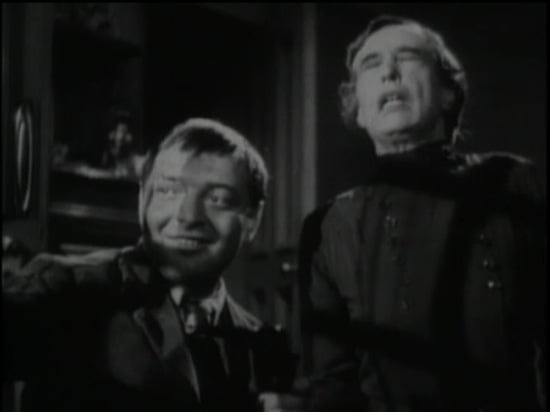Shocking Blocking (25)
By:
November 18, 2011

Fans of Peter Lorre want to see him triumph in his efforts, particularly when he’s the villain. (Except, perhaps, in M, where he’s a monster hunted by good guys and bad guys alike.) As I’ve noted before, this is due to Lorre’s characters’ ironic self-awareness, their longing to connect with intellectual equals (even if they’re ideological adversaries), and a kind of idealism that buoys them in every situation. In a world dominated by narrow-minded thugs, he’s an intellectual, a utopian, an aesthete, a cosmopolitan; I can relate. In Hitchcock’s original The Man Who Knew Too Much, Lorre portrays Abbott, ringleader of a group of assassins looking to provoke a world war. During a siege of his hideout, Abbott retains his aplomb, which makes him an inspiring figure — until his adjutant, Agnes (Cicely Oates, who died that same year) is shot. The blocking here is pure Hitchcock: tragic and comic at precisely the same instant. After this moment, Abbott is transformed into just another thug, and the audience begins to root for the thuggish cops.
An occasional series analyzing some of the author’s favorite moments in the positioning or movement of actors in a movie.
THIRTIES (1934–1943): It Happened One Night (1934) | The Man Who Knew Too Much (1934) | The Guv’nor (1935) | The 39 Steps (1935) | Young and Innocent (1937) | The Lady Vanishes (1938) | Mr. Smith Goes to Washington (1939) | The Big Sleep (1939) | The Little Princess (1939) | Gone With the Wind (1939) | His Girl Friday (1940)
FORTIES (1944–1953): The Diary of a Chambermaid (1946) | The Asphalt Jungle (1950) | The African Queen (1951)
FIFTIES (1954–1963): A Bucket of Blood (1959) | Beach Party (1963)
SIXTIES (1964–1973): For Those Who Think Young (1964) | Thunderball (1965) | Clambake (1967) | Bonnie and Clyde (1967) | Madigan (1968) | Wild in the Streets (1968) | Barbarella (1968) | Harold and Maude (1971) | The Mack (1973) | The Long Goodbye (1973)
SEVENTIES (1974–1983): Les Valseuses (1974) | Eraserhead (1976) | The Bad News Bears (1976) | Breaking Away (1979) | Rock’n’Roll High School (1979) | Escape from Alcatraz (1979) | Apocalypse Now (1979) | Caddyshack (1980) | Stripes (1981) | Blade Runner (1982) | Tender Mercies (1983) | Monty Python’s The Meaning of Life (1983)
EIGHTIES (1984–1993): Repo Man (1984) | Buckaroo Banzai (1984) | Raising Arizona (1987) | RoboCop (1987) | Goodfellas (1990) | Candyman (1992) | Dazed and Confused (1993) |
NINETIES (1994–2003): Pulp Fiction (1994) | The Fifth Element (1997)
OUGHTS (2004–13): Nacho Libre (2006) | District 9 (2009)
Joshua Glenn’s books include UNBORED: THE ESSENTIAL FIELD GUIDE TO SERIOUS FUN (with Elizabeth Foy Larsen); and SIGNIFICANT OBJECTS: 100 EXTRAORDINARY STORIES ABOUT ORDINARY THINGS (with Rob Walker).
